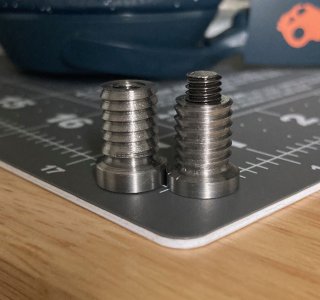- Joined
- Dec 13, 2020
- Messages
- 83
Hello. Last night I spent a few hours attempting to make a captive nut. My main goals were to
1. Practice single point threading on my mini lathe
2. Hit dimensions
3. Make something for my kids.
Everything was going well until I got to a point that I needed to make the threads. My target was 11.96 OD, which was hit (doubled checked). I set the top-slide to 30 degrees and arranged gears for a 1.75mm pitch. After scratch pass, I made few cuts and then it was a lot of repetition. I did begin to notice the diameter of the piece looked smaller . When I measured It was the perfect size for an M10. . . my target was M12.
I parted off the piece and chalked it up to good practice. Still felt really crappy going to bed since I wasted material and I didn't hit all of my goals.
I want to try again but had few questions:
- What did I do wrong ? Did I not zero the cross-slide. ?
- Why does the thread look rough? Is this chatter ?
1. Practice single point threading on my mini lathe
2. Hit dimensions
3. Make something for my kids.
Everything was going well until I got to a point that I needed to make the threads. My target was 11.96 OD, which was hit (doubled checked). I set the top-slide to 30 degrees and arranged gears for a 1.75mm pitch. After scratch pass, I made few cuts and then it was a lot of repetition. I did begin to notice the diameter of the piece looked smaller . When I measured It was the perfect size for an M10. . . my target was M12.
I parted off the piece and chalked it up to good practice. Still felt really crappy going to bed since I wasted material and I didn't hit all of my goals.
I want to try again but had few questions:
- What did I do wrong ? Did I not zero the cross-slide. ?
- Why does the thread look rough? Is this chatter ?





